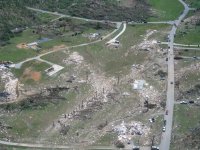rdale
EF5
Well, let's not go that far. There is a BIG difference between EF0 and EF5. Those who research tornadoes and develop new warning methodology to keep people alerted care. Does 4 versus 5 matter? No. But 0 to 5? Yep. Bigtime.
The Mayflower tornado was not given an EF-5 rating because it was found out the house that was reduced to a concrete slab was not secured with nuts and washers. Plus the cars close to the house where not moved and thus it was given a lesser intensity rating.
I'm not just taking any violent tornado and saying "it should have been (E)F5. Every tornado I've listed was based either on it containing 200+ mph winds, or based on its rating being disputed by at least a few experts. I'm not asking for a revision of the EF scale or a re-rating of any of the tornadoes so much as I'm listing tornadoes which were likely of F5/EF5 intensity at some point but never confirmed or given an official rating.Is this thread based on the desire to have measured winds be a part of the rating process? If so, I was unaware that many tornadoes had been sampled. Or, is this just disagreement with the assessment of the professionals who are the world's leading experts at rating tornado damage?
I've heard a good case made that if there should have been a fifth EF5 on 4/27/11, it should have been the Ringgold, GA storm which would have made it the first and only E/F5 in Georgia history.

My mistake, sorry. I meant NWS offices.Research centers don't do damage surveying - that's done by local NWS offices.
I've heard this too, though they seem to be taking their time with it - people have been talking about the rewrite effort since 2013, it seems. I guess it isn't exactly top priority, but it definitely would be more consistent and scientific to allow recorded wind speeds to factor into the rating.There is a big EF-scale rewrite effort in place now - one of the suggestions was to add more info into the database so radar-based winds, non-normal damage, etc. can be listed.
I'd like to add the Chickasha-Blanchard tornado of May 25, 2011 to this list based on the fact that trees in its path were literally reduced to stumps, and on the severe ground scouring.
Oops, typo. Anyhow, is there a dividing line between what degree of soil scouring constitutes F4/EF4 and F5/EF5 damage? Several tornadoes which have caused deep scouring haven't been rated F5/EF5.That was on 5/24/11.
